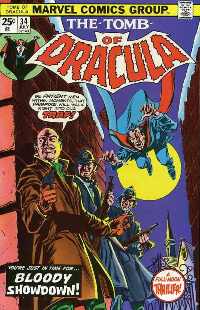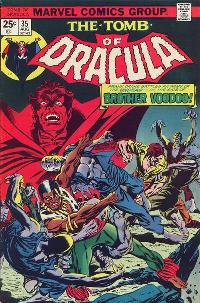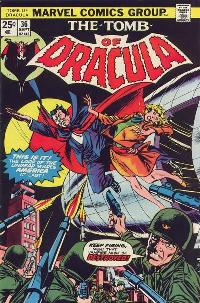| |
| At this point, Tomb
of Dracula had reached a level of quality both with
regard to the storytelling as well as the art which only
few comic book series ever attain. (For more background information
on the series, its creators, and its literary and
cinematographic inspirations,
you might wish to delve further into the
Tomb of Dracula)
|
| |
|
| |
Tomb
of Dracula
#34
July 1975
"Showdown
of blood!"
|
|
Story - Marv
Wolfman
Art - Gene Colan
Inks - Tom Palmer
Colours - Linda Lessman
Cover - Gil Kane
|
|
|
|
|
| |
 |
|
Dracula
receives informations
through one of his
servants from inside
Parliament which confirm
his suspicions that Dr
Sun is the cause of his
loss of power. Inspector
Chelm from Scotland Yard
is on the count's trail,
however, his planned
ambush on Dracula fails
in spite of silver
bullets with carved
crosses, and members of
his "vampire
squad" have to
rescue Chelm. Wolfman
sets up another subplot
as Dracula is observed
from a distance by a
white haired vampire who
muses to himself that
after years of pursuit
Dracula's time will soon
be up. In
Jaipur, Taj sees his
future life at the side
of his wife, now that his
vampire son is dead, and
he writes a farewell note
to Rachel van Helsing as
he moves on to his new
life and out of the comic
book. Taj was introduced
in Tomb of Dracula #3,
and Wolfman thus ends a
long-standing subplot and
retires a member of the
original gang of vampire
hunters.
Back
at Scotland Yard again,
Inspector Chelm together
with Harker and van
Helsing are joined by
psychologist Dr Scott,
and they all agree that
it must be Dr Sun who is
causing Dracula's loss of
vampiric powers.
|
|
|
|
|
| |
| Parallel to
these events, Wolfman also runs a storyline featuring
Daphne von Wilkinson, an aggressive businesswoman who
tries to use Dracula for her own private revenge,
offering the weakened vampire blood and information on Dr
Sun in return for a number of kills for her personal
profit. And finally, in Brazil, Frank Drake
finds himself in dire straits face to face with the
zombies but at the very last moment a bizare character
named Brother Voodoo appears to rescue him.
|
| |
|
| |
Tomb
of Dracula
#35
August
1975
"Hell
hath no fury!"
|
|
Story
- Marv Wolfman
Art - Gene Colan
Inks - Tom Palmer
Colours - Tom Palmer
Cover - Gil Kane
|
|
|
|
|
| |
|
| |
 |
|
Daphne
von Wilkinson's scheme
backfires as the victims
of her contract killings
- now turned into
vampires by Dracula - are
let loose on her by the
vampire count. Before
that, however, she has
provided Dracula with the
information that Scotland
Yard believes Dr Sun to
be in Boston (USA). In
Brazil, Brother Voodoo
prepares Frank Drake for
his battle against the
zombies. Together, they
defeat the walking dead
by driving them off of a
cliff. With the
deadly threat thus
vanquished, Brother
Voodoo and Frank Drake
begin searching for Danny
Summers, Drake's
so-called friend who
lured him down to Brazil
to be killed by zombies. The
way in which Wolfman and
Colan handled Tomb of
Dracula could easily
make readers forget that
this was, in fact, a
Marvel character. By the
mid-1970s, the logic of
the Marvel Universe had
become so stringent that
it was virtually
unconceivable that a
character of a Marvel
comic book could live in
his or her own little
world, and only a very
small handful managed to
stay clear of the current
timeframe and NYC locale
which formed the world in
which the likes of Reed
Richards or Peter Parker
lived.
|
|
|
|
|
| |
| In fact,
the force of the inner logic of the Marvel Universe was
so strong that even characters who started out in a
different timeframe, such as the Frankenstein Monster,
were eventually transported in time to interact with
other Marvel characters, as this had by now become a conditio
sine qua non for virtually any of the House of
Ideas' characters. The creative team behind Tomb of
Dracula was able to uphold the uniqueness of Dracula
for a surprisingly long time, adding to the possibility
that this ongoing tale just might take place in a world
which had only one supernatural element: plenty of
vampires but not a single costumed superhero. The way the
title was steadily weaving the rims of its own world and
purporting independence from the rest of Marvel's range
of characters escaped the attention of the editors in
charge for a long time, but not for ever, and one day
Marv Wolfman finally received clear orders from the inner
sanctum of the House of Ideas: to make sure people
knew that this was all happening in the "Marvel
Universe". The first such interaction had taken
place in Tomb of Dracula #18 with Werewolf by
Night, and now, almost 18 months later, Wolfman had to
once more establish contact with the rest of Marvel's
array of characters. Consciously avoiding any
super-heroes, he turned to Marvel's world of horror and
found Brother Voodoo - introduced in Strange Tales
#169 in September 1973 with plotting by Len Wein and
pencilling, conveniently, by Gene Colan.
"I
brought in Brother Voodoo because - as strange as the
name is - the character could fit (...) I just
absolutely turned down though every possible use of
writing the character with any other standard Marvel
heroes (...) that was a very conscious move on my
part."
(Marv Wolfman in an October 2005
interview with Comic Geek Speak Podcast)
More a
forced than a voluntary plot move by Wolfman, the result
was as uninspring as could be expected and displayed all
the lacklustre traits of Universal's 1940s productions of
"Dracula meets the Wolf-man plus Frankenstein plus
you-name-it". Brother Voodoo in Tomb of Dracula #35
is just that: a guest appearance for the sake of a guest
appearance.
|
| |
|
| |
Tomb
of Dracula
#36
September
1975
"Flight
of fear!"
|
|
Story
- Marv Wolfman
Art - Gene Colan
Inks - Tom Palmer
Colours - Tom Palmer
Cover - Gil Kane
|
|
|
|
|
| |
|
| |
 |
|
Noted
psychologist Dr Scott
meets again with Inpector
Chelm, Quincy Harker, and
Rachel Van Helsing to
give them eyewitness
accounts of Dracula's
flight to the United
States by highjacking a
U.S. Air Force test
flight over the
Atlantic. It is
quite clear that Dracula
has made his way to
Boston where he believes
Dr Sun to be in hiding. The
vampire hunters speedily
make preparations in
order to follow Dracula,
who seemingly has but one
week left to live.
However, Dr Scott is
revealed to the reader to
be working for Dr Sun as
he reports to him that he
has planted all the
proper clues in order to
mislead Harker and van
Helsing and make them
work - unbeknownst to
themselves - for Dr Sun's
plans.
In
Brazil, Frank Drake
learns that it was
Dracula who used an old
friend of his to lure him
to what would have been
his death had it not been
for Brother Voodoo.
|
|
|
|
|
| |
| The
arrival of Dracula in the US was bound to happen, and in
some ways it seems surprising that Wolfman had waited for
30 issues to move the storyline in this direction. Of
course, it made Tomb of Dracula more accessible
to the home market, as many readers would be able to
relate better to the comic this way. On the other hand,
some stories draw some of their lifeblood from the fact
that they do not happen on your doorstep. Wolfman seems
to have been quite aware of this by choosing Boston
rather than New York City for Dracula's arrival on
America's shore - after all, New England has its fair
share of spooky traditions too... With
hindsight, however, the move did not prove a winning
point for Tomb of Dracula, and although the
series would continue for almost another three years and
34 issues, some of the things that went wrong were
quintessentially rooted in the transfer to the US and
thus Tomb of Dracula #36.
|
| |
|
| |
WHERE
TO READ IT
The original issues of Tomb
of Dracula #31-36 can be found fairly
easily, but the overall classic status of the
series is reflected by higher prices in
comparison to other Bronze Age comic books. In a
collectable (VFN/very fine) condition these
issues will command around $25.00 (as per the
2013/14 Overstreet Price Guide) and are still
widely available in this grade. Copies intended
for reading more than collecting (in VG/very good
to G/good condition) sell for between $10.00 and
$5.00.
Alternatively, reading Tomb
of Dracula #31-36 in collected form is a
viable alternative as Marvel has reprinted this
early material in several forms. The most Dracula
you can get for your money comes, no doubt, in
the form of Essential Tomb of Dracula
volume 2, which collects issues #26-#49 as well
as Doctor Strange #14 and Giant-Size
Dracula #2-5). The only compromise here is
cheap quality paper (actually making the
Essentials close cousins of the originals in that
respect) and loss of colour as the reprints are
all black and white; whilst some feel that this
actually accentuates the wonderful Gene Colan
artwork, it does take away an original element of
the series.
A far more luxurious
collected edition is Marvel's Tomb of Dracula
Omnibus volume 2 (issue #31 is collected in
volume 1); however, this has been out of print
for some time, and although it can still be found
in places, it is quite common to see outright
silly prices asked even for second-hand copies.
|
|
| |
|
| |
|
| |
or venture
INTO
THE TOMB OF DRACULA
HOW MARVEL'S MOST
SUCCESSFUL HORROR COMIC BOOK TITLE CAME ABOUT
AND HOW IT CHANGED COMIC BOOKS
|
|
| |
|
| |
The
illustrations presented here are copyright
material and are reproduced for strictly
non-commercial and appreciative review
purposes only.
Text is (c) 2006-2014 A. T. Wymann
page
originally posted on the web 19 June 2006
page completely revised 1 October 2009
reposted 22 March 2014
|

